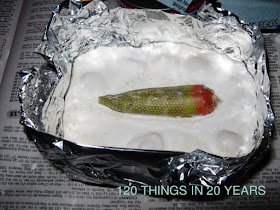Continued from part 1
The plaster has dried to a clinking sound when tapped with a spoon.
My fist step is to unwrap it, and gently prise the lure from the plaster.
Next is to replace the lure in the mold and lubricate both the mold and the lure to make sure nothing sticks to either.
It turns out, that there is some kind of natural limit as to precisely how much of someone else's lip balm you can use on a mold making project.
I'll be trying soap this time.
I built up a new wall surrounding the bottom mold and model.
With all surfaces soaped, and some luck, the top half of the mold will separate cleanly once it's set.
I mixed up a second batch of plaster and water in random proportions.
After stirring for a minute or two, I poured it over the lure, and filled the foil box.
I have no idea if I need to do all this waiting. I really want a result so I'm going to wait until its totally dry but I think I can get away with opening it tomorrow morning.
Even though I'm doing my usual "fools rush in" approach to learning how to make molds, I am actually studying hard in an attempt learn how to do this properly. I've found I understand a lot more of the stuff I'm researching if I've had some exposure to the materials involved. With that in mind, I should be able to make a decent mold.
But this might not be it.
WARNING !!! Plaster can get very hot when setting
google search for: plaster of paris third degree burns



No comments:
Post a Comment